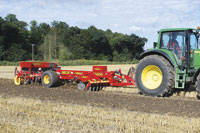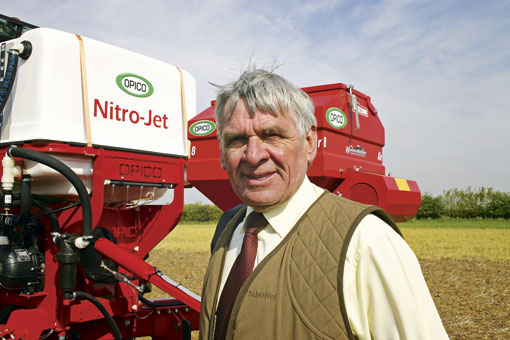Vaderstad TopDown tops out in Masstock OSR trial

To plough or not to plough? Direct-drill or sub-soil and seed in one pass? These are questions that are at the forefront of many oilseed rape growers’ minds at this time of year.
Of course, there is no clear-cut answer – the right approach will differ from farm to farm. But the latest results from field trials at Masstock’s Brotherton Smart Farm research centre in Yorkshire suggest different tillage techniques produce markedly different results.
Three different systems were used to get crops of Excalibur into light sandy soils.
1 With the first, a 3m-wide Vaderstad TopDown equipped with full-width seeder-box was used. Combining two rows of discs, three banks of rigid tines and a ring-press, it was working down to a depth of 250mm.
2 The second method used a 6m Kuhn Cultitiller rotovator kitted out with deep soil-loosening legs. A power-harrow combination drill then followed.
3 The final approach was the most intensive. First a subsoiler was used. This was followed by a seven-furrow plough and finally the combi-drill was used to get the seed in the ground.
With all three techniques the crop was drilled at two different rates – 25 seeds/sq m and 75 seeds/sq m.
The results?
“The trial confirmed exactly what we already knew,” says Masstock technical manager Philip Marr.
“On average, yields were down by 0.65t/ha with the higher seed rates. That’s purely down to the fact that the high plant populations result in thin stems which can’t hold the fully-podded plant up.
“By the time harvest comes around they’re lodged and have shed much of their seed.”
As to which tillage technique is best, the answer is fairly clear. Costing much less than the two more intensive systems, the TopDown approach produces almost 1t/ha more yield.
“Working and re-working the ground until it is just dust costs money and doesn’t result in any better crop.”
“Because the TopDown was only working the top 8in, it wasn’t disturbing weed seeds and so the crop wasn’t struggling to compete.”
The rotavator brought cereal seeds in particular to the surface. On average there were some 50 grassweeds per sq m, resulting in a mat of annual meadowgrass and cereal volunteers.
Ploughing brought all manner of broad-leaved seeds to the surface, making for difficult weed control in an oilseed rape crop. But it also seemed to bury grassweeds while the other non-inversion approaches saw just 2-3 weeds or volunteers a square metre thanks to the reduced soil disturbance.
“Judging this trial alongside our other research work, it’s clear that the more intensive the cultivation regime you use, the more weed problems you’ll dig up and the more you’ll spend,” says Mr Marr. “The key is to set seed rates by the conditions in the field on the day, always aiming for 20-25 plants/sq m in March.
“My advice would be to use a tillage technique that minimises surface disturbance and maximises the rooting potential of the plant.
Method | Seed rate | Cost £/ha | Av Plant wt Oct | GAI February | Yield t/ha |
Vaderstad Topdown | 25seeds/sq m | 42 | 8.2g | 1.2 | 4.08 |
75seeds/sq m | 3.3 (30% lodging) | ||||
Kuhn Soil Loosener/Combi Drill | 25seeds/sq m | 124 | 4.6g | 0.6 | 3.1 |
75seeds/sq m | 2.98 (55% lodging) | ||||
Sub-soil/Plough/Combi Drill | 25seeds/sq m | 156 | 5.1g | 0.75 | 3.25 |
75seeds/sq m | 2.76 (60% lodging) |
Figures provided by Masstock Farm Consultancy
Autumn fertiliser sees yields rocket in Masstock oilseed rape trial
If you’re thinking about applying fertiliser at drilling to get crops off to an early start, it’s certainly worth taking heed of what’s been found in the last year at Masstock’s Brotherton Smart Farm in Yorkshire.
Technical manager Philip Marr has established what he believes to be the optimum rate of nitrogen application to seedbeds for maximum yield return.
|
|---|
“Band-spreading fertiliser onto the plant rows at sowing has come under the spotlight in recent years and we’ve been looking at just how much is needed to get the optimum yield effect,” he explains.
Excalibur was sown at a rate of 25 seeds/sq m into sandy soil using two different techniques.
The first employed a Simba DTX300 fitted with a seeder unit and granular fertiliser applicator. A combination of tines, two rows of scalloped discs and a ring-press, it loosens the top 400mm and provides a chopping/mixing effect to produce a tilth on the soil surface.
The second approach used a straightforward Opico He-Va sub-soiler, again equipped with seeder and fertiliser applicator.
With both pieces of kit two different fertiliser regimes were used on the autumn seedbed. Applied in a band, fertiliser at 20kg/ha of N equates to a spot rate of 60kg/N in the plant row. Correspondingly a 40kg/ha of N rate results in 120kg/N in the band.
The result?
“Almost as soon as the young seedlings were up and away we could see the difference between those that had a dose of N and those that didn’t,” says Mr Marr.
“By mid October on the 20kg/ha of N plots, the average plant weight was over double that of those that hadn’t had a drop.”
But upping the rate to 40kg/ha of N had little extra benefit – a trend that continued through the year-long trial right up to the final yield results at harvest.
The proof of the pudding is, of course, in the harvest.
Where the plots of Excalibur that hadn’t had any autumn fertiliser were yielding between 3.7-3.8t/ha, those that received 20kg/ha of N rocketed up to around 4.3t/ha.
“Fitting a fertiliser applicator to the cultivator and spending around £15/ha on Nitram brought a yield advantage of half a tonne. In today’s money that equates to £135/ha extra income,” says Mr Marr.
Method | Cost £/ha | Av Plant wt Oct | GAI February | Yield t/ha |
Simba DTX300 |
| |||
No Nitrogen @ drilling | 39 | 6.8 gms | 1.1 | 3.84 |
20 kgs Nitrogen in band | 59.34* | 14.65 gms | 1.5 | 4.27 |
40 kgs Nitrogen in band | 72.68* | 16.12 gms | 1.6 | 4.3 |
Opico He-Va Subsoiler |
| |||
No Nitrogen @ drilling | 32 | 7.2 gms | 1 | 3.73 |
20 kgs Nitrogen in band | 52.34* | 16.21 gms | 1.7 | 4.39 |
40 kgs Nitrogen in band | 65.68* | 17.14 gms | 1.8 | 4.41 |
Figures provided by Masstock Farm Consultancy and Nix Farm Management Pocketbook
* Includes £13.34/ha or £26.68/ha for fertiliser and £7/ha for applicator


